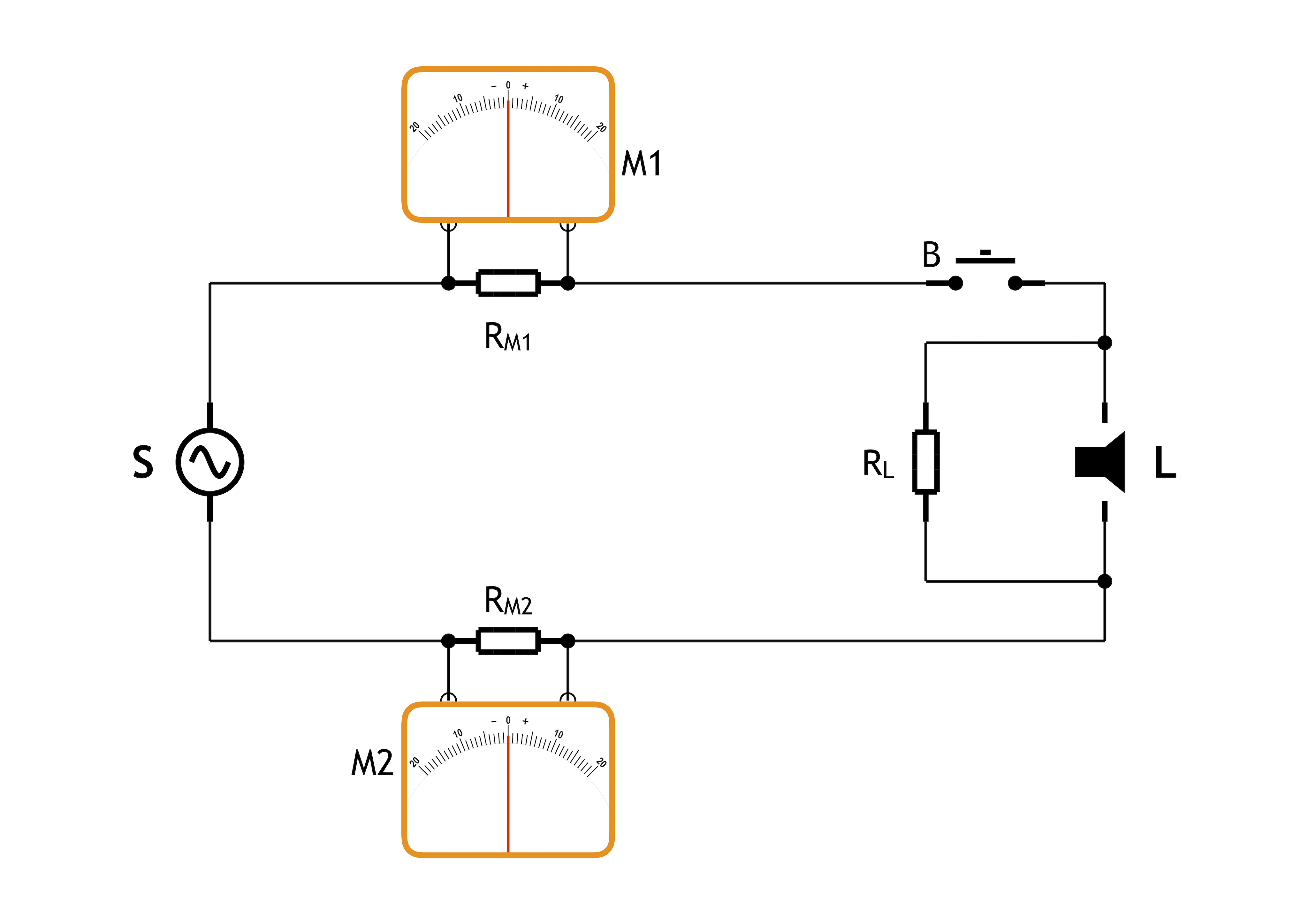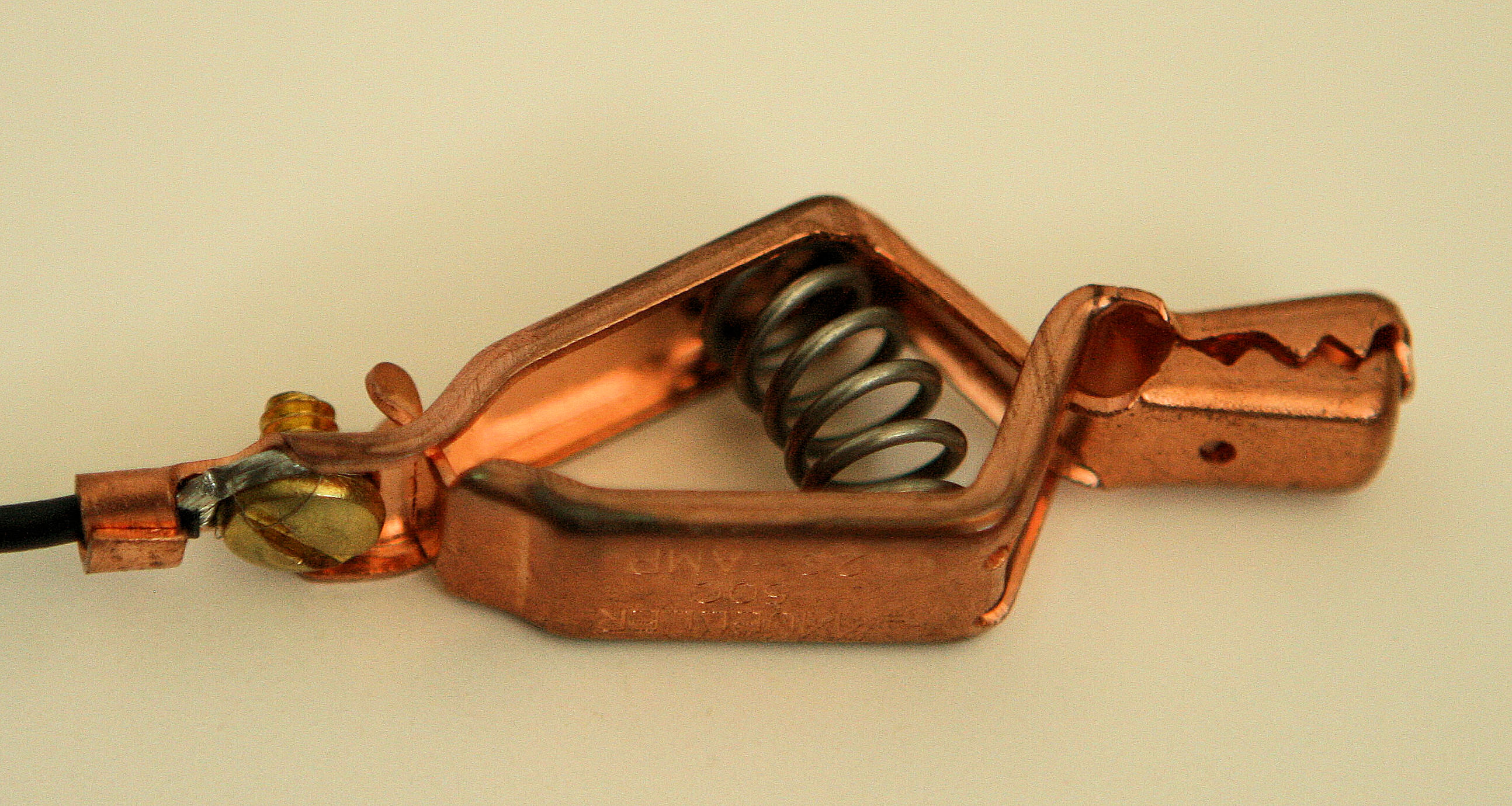|
Kelvin Connection
Four-terminal sensing (4T sensing), 4-wire sensing, or 4-point probes method is an electrical impedance measuring technique that uses separate pairs of current-carrying and voltage-sensing electrodes to make more accurate measurements than the simpler and more usual two-terminal (2T) sensing. Four-terminal sensing is used in some ohmmeters and impedance analyzers, and in wiring for strain gauges and resistance thermometers. Four-point probes are also used to measure sheet resistance of thin films (particularly semiconductor thin films). Separation of current and voltage electrodes eliminates the lead and contact resistance from the measurement. This is an advantage for precise measurement of low resistance values. For example, an LCR bridge instruction manual recommends the four-terminal technique for accurate measurement of resistance below 100 ohms.Manual for the Racal-Dana Databridge 9343M: "If the resistance value is low, less than 100 ohms, make a four-terminal connecti ... [...More Info...] [...Related Items...] OR: [Wikipedia] [Google] [Baidu] |
Kelvin Bridge
A Kelvin bridge, also called a Kelvin double bridge and in some countries a Thomson bridge, is a measuring instrument used to measure unknown electrical resistors below 1 ohm. It is specifically designed to measure resistors that are constructed as four terminal resistors. Background Resistors above about 1 ohm in value can be measured using a variety of techniques, such as an ohmmeter or by using a Wheatstone bridge. In such resistors, the resistance of the connecting wires or terminals is negligible compared to the resistance value. For resistors of less than an ohm, the resistance of the connecting wires or terminals becomes significant, and conventional measurement techniques will include them in the result. To overcome the problems of these undesirable resistances (known as 'parasitic resistance'), very low value resistors and particularly precision resistors and high current ammeter shunts are constructed as four terminal resistors. These resistances have a pair of ... [...More Info...] [...Related Items...] OR: [Wikipedia] [Google] [Baidu] |
Electrical Measurements
Electrical measurements are the methods, devices and calculations used to measure electrical quantities. Measurement of electrical quantities may be done to measure electrical parameters of a system. Using transducers, physical properties such as temperature, pressure, flow, force, and many others can be converted into electrical signals, which can then be conveniently measured and recorded. High-precision laboratory measurements of electrical quantities are used in experiments to determine fundamental physical properties such as the charge of the electron or the speed of light, and in the definition of the units for electrical measurements, with precision in some cases on the order of a few parts per million. Less precise measurements are required every day in industrial practice. Electrical measurements are a branch of the science of metrology Metrology is the scientific study of measurement. It establishes a common understanding of units, crucial in linking human activities ... [...More Info...] [...Related Items...] OR: [Wikipedia] [Google] [Baidu] |
Schlumberger Array Configuration
An electrode array is a configuration of electrodes used for measuring either an electric current or voltage. Some electrode arrays can operate in a bidirectional fashion, in that they can also be used to provide a stimulating pattern of electric current or voltage. Common arrays include: *Schlumberger (Wenner) *Wenner alpha *Wenner beta *Wenner gamma *Pole-pole *Dipole-dipole *Pole-dipole *Equatorial dipole-dipole Resistivity Resistivity measurement of bulk materials is a frequent application of electrode arrays. The figure shows a Wenner array, one of the possible ways of achieving this. Injecting the current through electrodes separate from those being used for measurement of potential has the advantage of eliminating any inaccuracies caused by the injecting circuit resistance, particularly the contact resistance between the probe and the surface, which can be high. Assuming the material is homogenous, the resistivity in the Wenner array is given by: :\rho=2 \pi a \frac ... [...More Info...] [...Related Items...] OR: [Wikipedia] [Google] [Baidu] |
Wenner Array Configuration
An electrode array is a configuration of electrodes used for measuring either an electric current or voltage. Some electrode arrays can operate in a bidirectional fashion, in that they can also be used to provide a stimulating pattern of electric current or voltage. Common arrays include: *Schlumberger (Wenner) *Wenner alpha *Wenner beta *Wenner gamma *Pole-pole *Dipole-dipole *Pole-dipole *Equatorial dipole-dipole Resistivity Resistivity measurement of bulk materials is a frequent application of electrode arrays. The figure shows a Wenner array, one of the possible ways of achieving this. Injecting the current through electrodes separate from those being used for measurement of potential has the advantage of eliminating any inaccuracies caused by the injecting circuit resistance, particularly the contact resistance between the probe and the surface, which can be high. Assuming the material is homogenous, the resistivity in the Wenner array is given by: :\rho=2 \pi a \frac ... [...More Info...] [...Related Items...] OR: [Wikipedia] [Google] [Baidu] |
Electrode Array
An electrode array is a configuration of electrodes used for measuring either an electric current or voltage. Some electrode arrays can operate in a bidirectional fashion, in that they can also be used to provide a stimulating pattern of electric current or voltage. Common arrays include: *Schlumberger (Wenner) *Wenner alpha *Wenner beta *Wenner gamma *Pole-pole *Dipole-dipole *Pole-dipole *Equatorial dipole-dipole Resistivity Resistivity measurement of bulk materials is a frequent application of electrode arrays. The figure shows a Wenner array, one of the possible ways of achieving this. Injecting the current through electrodes separate from those being used for measurement of potential has the advantage of eliminating any inaccuracies caused by the injecting circuit resistance, particularly the contact resistance between the probe and the surface, which can be high. Assuming the material is homogenous, the resistivity in the Wenner array is given by: :\rho=2 \pi a \frac w ... [...More Info...] [...Related Items...] OR: [Wikipedia] [Google] [Baidu] |
ATX Power Supply
ATX (Advanced Technology eXtended) is a motherboard and power supply configuration specification developed by Intel in 1995 to improve on previous de facto standards like the AT design. It was the first major change in desktop computer enclosure, motherboard and power supply design in many years, improving standardization and interchangeability of parts. The specification defines the dimensions; the mounting points; the I/O panel; and the power and connector interfaces among a computer case, a motherboard, and a power supply. Overview ATX is the most common motherboard design. Other standards for smaller boards (including microATX, FlexATX, nano-ITX, and mini-ITX) usually keep the basic rear layout but reduce the size of the board and the number of expansion slots. Dimensions of a full-size ATX board are , which allows many ATX chassis to accept microATX boards. The ATX specifications were released by Intel in 1995 and have been revised numerous times since. The most re ... [...More Info...] [...Related Items...] OR: [Wikipedia] [Google] [Baidu] |
Shunt (electrical)
In electronics, a shunt is a device that creates a low- resistance path for electric current, to allow it to pass around another point in the circuit.Rudolf F. Graf, ''Modern dictionary of Electronics'', Mc-Graw Hill, 1968 Library of Congress 68-13873 ''Shunt'' page 454. The origin of the term is in the verb 'to shunt' meaning to turn away or follow a different path. Defective device bypass One example is in miniature Christmas lights which are wired in series. When the filament burns out in one of the incandescent light bulbs, the full line voltage appears across the burnt out bulb. A shunt resistor, which has been connected in parallel across the filament before it burnt out, will then short out to bypass the burnt filament and allow the rest of the string to light. If too many lights burn out however, a shunt will also burn out, requiring the use of a multimeter to find the point of failure. Photovoltaics In photovoltaics, the term is widely used to describe an '' ... [...More Info...] [...Related Items...] OR: [Wikipedia] [Google] [Baidu] |
Power Supplies
A power supply is an electrical device that supplies electric power to an electrical load. The main purpose of a power supply is to convert electric current from a source to the correct voltage, current, and frequency to power the load. As a result, power supplies are sometimes referred to as electric power converters. Some power supplies are separate standalone pieces of equipment, while others are built into the load appliances that they power. Examples of the latter include power supplies found in desktop computers and consumer electronics devices. Other functions that power supplies may perform include limiting the current drawn by the load to safe levels, shutting off the current in the event of an electrical fault, power conditioning to prevent electronic noise or voltage surges on the input from reaching the load, power-factor correction, and storing energy so it can continue to power the load in the event of a temporary interruption in the source power (uninterruptible p ... [...More Info...] [...Related Items...] OR: [Wikipedia] [Google] [Baidu] |
Ohm's Law
Ohm's law states that the current through a conductor between two points is directly proportional to the voltage across the two points. Introducing the constant of proportionality, the resistance, one arrives at the usual mathematical equation that describes this relationship: :I = \frac, where is the current through the conductor, ''V'' is the voltage measured ''across'' the conductor and ''R'' is the resistance of the conductor. More specifically, Ohm's law states that the ''R'' in this relation is constant, independent of the current. If the resistance is not constant, the previous equation cannot be called ''Ohm's law'', but it can still be used as a definition of static/DC resistance. Ohm's law is an empirical relation which accurately describes the conductivity of the vast majority of electrically conductive materials over many orders of magnitude of current. However some materials do not obey Ohm's law; these are called non-ohmic. The law was named after ... [...More Info...] [...Related Items...] OR: [Wikipedia] [Google] [Baidu] |
Kelvin Connection Layout
The kelvin, symbol K, is the primary unit of temperature in the International System of Units (SI), used alongside its prefixed forms and the degree Celsius. It is named after the Belfast-born and University of Glasgow-based engineer and physicist William Thomson, 1st Baron Kelvin (1824–1907). The Kelvin scale is an absolute thermodynamic temperature scale, meaning it uses absolute zero as its null (zero) point. Historically, the Kelvin scale was developed by shifting the starting point of the much-older Celsius scale down from the melting point of water to absolute zero, and its increments still closely approximate the historic definition of a degree Celsius, but since 2019 the scale has been defined by fixing the Boltzmann constant to be exactly . Hence, one kelvin is equal to a change in the thermodynamic temperature that results in a change of thermal energy by . The temperature in degree Celsius is now defined as the temperature in kelvins minus 273.15, meaning ... [...More Info...] [...Related Items...] OR: [Wikipedia] [Google] [Baidu] |
Crocodile Clip
Alligator clip A crocodile clip or alligator clip is a plier-like spring-tensioned metal clip with elongated, serrated jaws that is used for creating a temporary electrical connection. This simple mechanical device gets its name from the resemblance of its serrated jaws to the toothed jaws of a crocodile or alligator. It is used to clamp and grab onto a bare electrical cable to an lead on a battery or some other electrical component. Functioning much like a spring-loaded clothespin, the clip's tapered, serrated jaws are forced together by a spring to grip an object. When manufactured for electronics testing and evaluation, one jaw of the clip is typically permanently crimped or soldered to a wire, or is bent to form the inner tubular contact of a ~ female banana jack, enabling quick non-permanent connection between a circuit under test and laboratory equipment or to another electrical circuit. The clip is typically covered by a plastic shroud or "boot" to prevent accidental ... [...More Info...] [...Related Items...] OR: [Wikipedia] [Google] [Baidu] |





